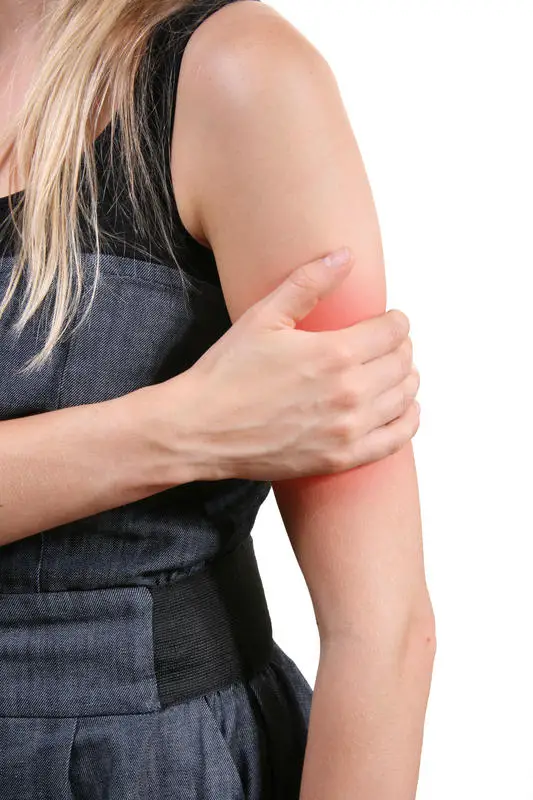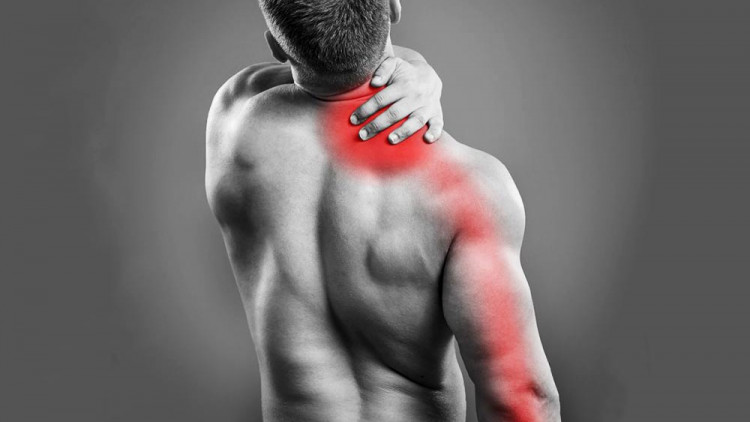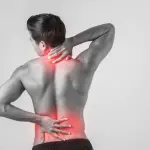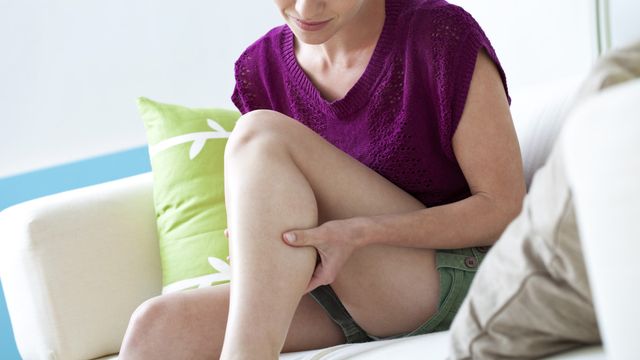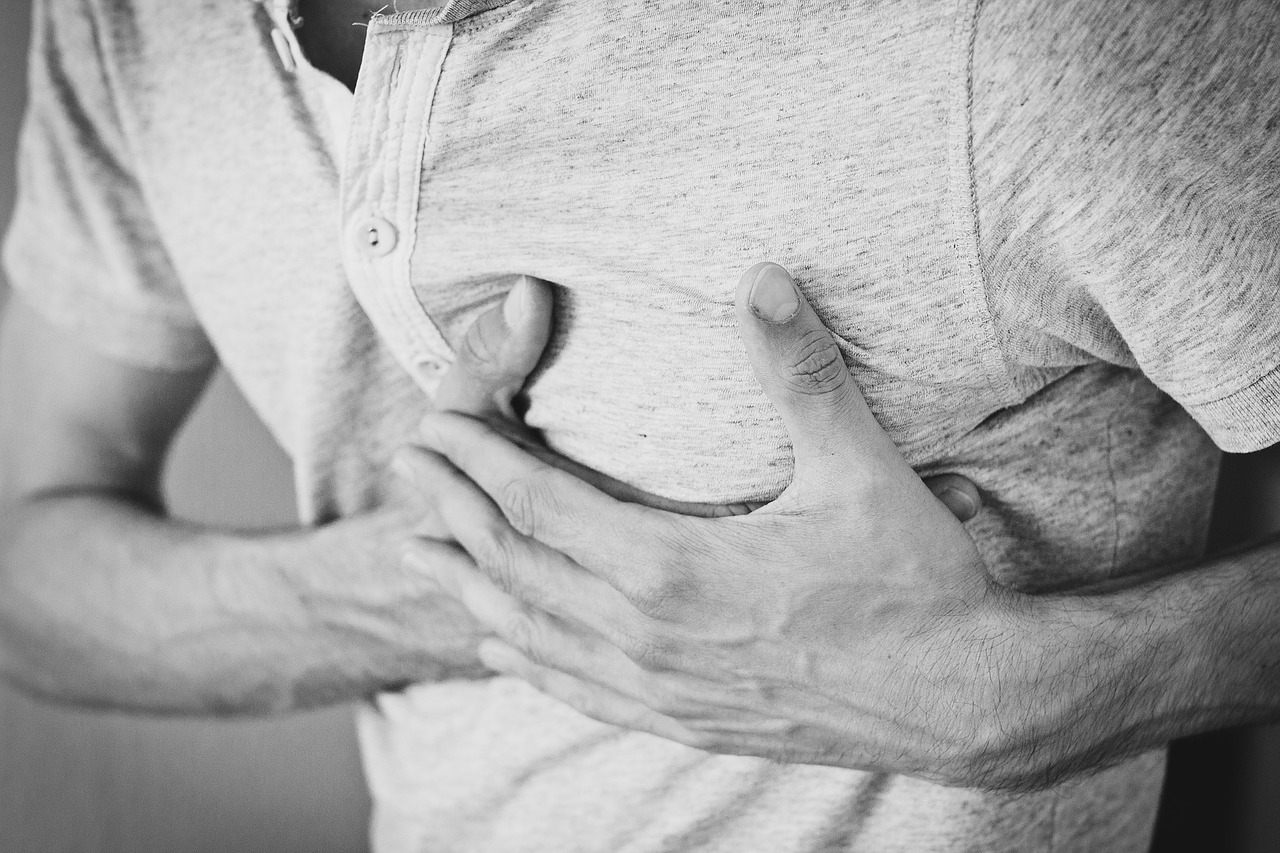The occurrence of left arm pain is generally a source of anguish and great worry, because it is generally associated with a dreadful condition: myocardial infarction, commonly called " heart attack ".
Fortunately, pain in the left arm is not always synonymous with a heart attack. Many pathologies can be the cause.
In all cases, the opinion of a doctor is essential in front of any pain in the left arm so as not to miss a serious pathology.
Left arm pain: definition
In anatomy, we mean by " arms " the part of the upper limb that extends from the shoulder to the elbow. Any pain that sits at this level is therefore designated by "arm pain".
It is important to specify the characteristics of this pain, because this is what will help the doctor to ask the correct diagnosis. To do this, a careful questioning, a complete physical examination (which is not limited to the left arm) and any additional examinations are necessary.
Thus, the clinical and paraclinical data will make it possible to determine the type of pain:
- Pain localized to the left arm or diffused to the whole upper limb.
- Acute or chronic pain.
- Sharp pain that appeared following a trauma.
- Pain associated with deformity or swelling of the arm.
- Pain appeared following the hyper-solicitation of the arm.
- Pain that worsens when straining the arm.
- Electric pain.
- Pain accompanied by tingling or burning sensation.
- Pain associated with shortness of breath, chest pain and jaws who do not yield to rest in a context of general malaise.
Of course, in medicine, we do not treat a symptom but a patient! It is therefore essential to know the personal and family history of the latter, to specify the context of his pain in the left arm, its triggering factors…
For example, a left arm pain associated with chest pain in an elderly patient with a cardiovascular history will direct us first and foremost to a myocardial infarction. The terrain is very important in these kinds of situations.
6 Possible Causes of Left Arm Pain
Pain in the left arm can be caused by:
- Cardiac (myocardial infarction).
- Tendinitis (tendonitis of the long biceps).
- Bone (humerus fracture).
- Nervous (cervico brachial neuralgia).
- Articular (rheumatoid arthritis).
- Muscular (fibromyalgia).
1- Myocardial infarction (heart attack)
Myocardial infarction, better known as " heart attack ", is a condition characterized by the destruction of a more or less extensive part of the myocardium (muscle of the heart) following an obstruction (partial or total) of one or more arteries of the heart.
Clinically, myocardial infarction is manifested by pain thoracic brutal retrosternal, generally on the occasion of an effort, not yielding to rest, radiating to the left arm (or even the two upper limbs) and the jaw.
Sometimes, myocardial infarction is manifested by atypical symptoms such as digestive disorders (stomach pain, nausea, vomiting, etc.), isolated pain in the left arm or jaw.
Thus, pain in the left arm, even isolated, should never be taken lightly, as it can be a sign of a heart attack, a fatal condition if not treated as soon as possible. So, at the slightest doubt, go to the emergency room or call the emergency services (15)!
2- Tendinitis of the long biceps
La tendonitis of the long biceps, or biceps brachii tendonitis, is a common cause of arm pain. It is manifested by pain in the front of the shoulder and down to the arm.
This pain is triggered during the upset flexion (against resistance) of the forearm on the arm. It can also appear when stretching the biceps muscle, which is why some call it “wallet syndrome” (appearance of pain when you put your hand on the back pocket of the pants to take your wallet, because this causes the stretching of the biceps muscle and its tendon).
Other possible symptoms of long biceps tendinitis are swelling, redness and muscle weakness in the shoulder (inflammatory signs) with reduced mobility.
Long biceps tendonitis can occur at any age. Its causes are various:
- Hyper-Use ou overuse: overuse of the biceps brachii muscle is the most common cause of biceps longus tendinitis. It is often found among athletes, workers (chain work with stereotyped gestures)...
- Heavy load port: tendonitis of the long biceps is frequently seen in the field of bodybuilding (bodybuilding, bodybuilding, weight lifting, etc.), among movers, construction workers, etc.
- Shoulder trauma: for example, fall with landing on the anterior face of the shoulder. This is a fairly rare cause of tendinitis of the long biceps.
The treatment of tendonitis of the long biceps is essentially based on the muscle rest affected, taking non-steroidal anti-inflammatory drugs, applying ice packs to the painful area and targeted exercises to strengthen the affected area. It is recommended to consult a physiotherapist (physiotherapist) or an osteopath for better care.
It is common for tendonitis to reappear a few weeks/months after healing. It is therefore necessary to prevent recurrences by changing professional or sports habits (avoid repetitive movements and carrying too heavy loads, take breaks during prolonged efforts, etc.).
3- Fracture of the humerus
A fracture of the arm manifests itself, of course, by pain! This is not always obvious, because the pain may not be felt immediately (sometimes due to the adrenaline secreted in large quantities during a violent trauma).
The signs in favor of a fracture of the humerus are:
- Evocative context (notion of accident, fall or other trauma, area of bone fragility such as osteoporosis, etc.).
- Cracking sensation in the arm during the trauma.
- Functional impotence (difficulty or impossibility to mobilize the arm) with Desault attitude (the healthy limb supports the injured limb).
- Exquisite pain in the arm, which can be reproduced by pressure on the injured area.
- Deformation or shortening of the arm.
- Swelling (oedema), redness (ecchymosis or hematoma) in the arm or shoulder stump.
The diagnosis of humeral fracture is based on clinical data supplemented by a radiography standard of the arm (face and profile shots). The latter will make it possible to confirm the diagnosis and to specify the characteristics of the fracture, in order to adapt the care.
The treatment of a humerus fracture consists of repositioning the bone fragments and then immobilizing the upper limb with a plaster thoraco-brachialis (or using a splint in an “elbow to body” position).
Sometimes, faced with a comminuted fracture (complex, with several fragments) or very unstable (significant displacement, etc.), the surgery remains the treatment of choice (osteosynthesis, nailing, etc.).
4- Cervicobrachial neuralgia
La cervico brachial neuralgia is a pain – like an electric shock, burning or vice-like sensation – of neurological origin which begins in the cervical region and ends in one or more fingers of the hand, passing through the arm and the forearm.
In addition to this pain having a characteristic path, cervico-brachial neuralgia is accompanied by sensitivity disorders such as tingling in the fingers or a board-like feeling when an object is touched.
In more advanced cases, difficulty in performing certain simple gestures (writing, buttoning his shirt, etc.) appears, as well as muscle cramps, muscle wasting, finger retraction and, in the final stage, paralysis.
Cervicobrachial neuralgia is caused by compression of one or more nerve roots inside or at their exit from the spinal canal.
This nerve compression can be caused by:
- A cervical disc herniation : dehiscence of the posterior wall of a intervertebral disc neck and expulsion of a piece of the latter which compresses a spinal nerve. This disco-radicular impingement is at the origin of a pinching of the root, which translates clinically into pain all along the path of the latter.
- A cervical spondylosis ou cervicarthrose : bone and ligament degeneration due to aging leads to a reduction in the holes through which the spinal nerves exit. Their root is therefore crushed when passing through these narrow holes, which irritates the nerves and triggers cervico-brachial neuralgia.
- A tumor ou a bone fracture: much rarer cause of cervico-brachial neuralgia.
The treatment of cervico-brachial neuralgia depends on several parameters, in particular the cause, the stage of evolution and the clinico-radiological assessment.
Here are some of the therapeutic weapons we have to treat this condition:
- Medical component ou “conservative treatment” : are intended only to relieve pain:
- Rest / immobilization by cervical collar.
- Analgesics (from paracetamol to morphine).
- Steroidal and non-steroidal anti-inflammatory drugs.
- Cervical infiltration of cortisone.
- Physiotherapy (massages, gentle muscle strengthening).
- Surgical component: in the event of failure of well-conducted medical treatment. The purpose of the surgery is to decompress the nerve roots by removing the herniated disc fragment and placing a prosthesis in its place or by merging the two vertebrae adjacent. Other surgical techniques exist depending on the exact cause of the compression.
To know everything about cervico-brachial neuralgia, see the following article.
5- Articular origin
Sometimes left arm pain comes from damage to the shoulder or elbow joints. Here are some joint pathologies that can cause pain in the left (or right) arm:
- Rheumatoid arthritis (autoimmune disease mainly affecting the small joints).
- Septic arthritis (infection in a joint).
- Lyme disease (transmitted by a tick bite).
- Gout (possible elbow damage, but relatively rare).
- Psoriatic arthritis.
6- Fibromyalgia
Fibromyalgia is a condition characterized by widespread pain throughout the body evolving in a context of profound asthenia (great fatigue) and sleep disorders.
Its precise mechanism remains unappreciated nowadays. Several hypotheses have been put forward, in particular hormonal disturbances, an increase in the pain perception threshold, anomalies in the functioning of the nervous system, the involvement of genetic factors, etc.
Pain usually begins in the neck and shoulders. They then extend to the back, thorax, with both arms and the legs. In some cases, a simple touch of the skin can trigger pain throughout the body. This phenomenon is called allodynia ».
What to do in front of a pain in the left arm?
The attitude to have in front of a pain in the left arm depends of course on the causes. The most important thing is to know recognize the urgency absolute represented by myocardial infarction. In the slightest doubt, go as soon as possible to a doctor in order to benefit from an electrocardiogram and adequate care.
In the event of trauma (fall, false movement, etc.), moderate pain in the arm can be relieved by resting the arm, taking simple analgesics (paracetamol), non-steroidal anti-inflammatory drugs (tablets, capsules or ointment) and the application of cold to the painful area. A physical therapist (physiotherapist) or osteopath can greatly help relieve symptoms.
Tools and accessories can provide short-term pain relief and improve quality of life (especially if the cause is cervical). However, it should be noted that these methods will not necessarily correct the cause of the problem in the long term.
- 【Multifunctional Physiotherapy】The acupressure kit set includes an acupressure mat and pillow, and 2 massage balls. You can use the acupressure set in different ways and on different parts of the body, such as lower back pain, insomnia, chronic stress, fatigue, tension, circulatory disorders, etc.
- 【Safe and Premium Material】The acupressure mat massager, cushion cover and storage bag are made of 100% cotton, the inside is 21D high-density eco-friendly sponge. The massage nail is made of non-toxic ABS plastic. 100% natural without side effects, hypoallergenic.
- 【Natural Ancient Indian Healing】 The acupressure mat has 230 massage nails, 6210 massage points, the pillow has 73 massage nails, 1971 massage points. Your weight is evenly distributed into thousands of small pieces to stimulate countless acupuncture points. Ideal for relaxation and promoting circulation. The size of the acupressure mat is 68*42cm, the size of the massage pillow is 37 x 15 x 10cm.
- Relieve Aches – The RENPHO neck massager gives you the benefits of a professional shiatsu massage at home, saving you time and money. Its ergonomic U-shaped design and 8 deep kneading nodes simulate human fingers to create a super comfortable deep shiatsu massage. This shiatsu massager relieves pain for the whole body; for use on neck, shoulders, back, legs, thighs, calves and feet
- Heating - This shoulder massager includes heat functions, which more effectively relieve muscle aches and tension, aches, pains and release trigger points while improving overall circulation. Vibration and heat functions can be turned on or off independently
- MULTIPLE INTENSITIES AND DIRECTIONS - This neck massager will take the worry out of a sudden change in direction when you've found the sweet spot. It will keep a kneading shiatsu massage in one direction until you want to change it. Combine this with 3 speed levels and your pulling strength to surely find the right intensity to relieve muscle pain
- ERGONOMIC DESIGN: The graceful curves of this manual neck massager roller are the perfect combination of form and function. Different from other massage therapy tools, the neck massager looks more cute and humanized,
- RELIEVES MUSCLE STIFFNESS AND Aches: The 6 wheel neck massager is the perfect muscle massager tool for relieving spasms (knots) or trigger point muscles. By applying pressure to the affected muscle patch, blood circulation is stimulated bringing in more oxygen and nutrients for faster muscle relief and recovery.
- Less Effort: This portable massager has a longer handle and uses the principle of leverage, which is more comfortable and less labor intensive. Compared to direct massage with the hands, less than 1/4 of the force is needed. Enjoy relaxation without feeling tired at the same time. When you squeeze the handle, the strength of the force is controllable.
- 30 LEVELS Massage Gun:ALDOM massage gun Choose the speed and massage heads that best suit your needs can quickly eliminate lactic acid produced after exercise, and for everyday relieve muscle pain, back and neck aches and stiffness, greatly reducing the time muscle recovery.
- Long Battery Life: Equipped with high quality battery, the muscle massager can keep working about 6-8 hours after charging, while the cooling system can effectively remove excess heat, if the battery is low, there will be a red prompt.
- Less than 45 dB Ultra Low Noise: ALDOM muscle massager gun which features high performance and low noise. features advanced technology and high-torque non-brushed electric motor, Featuring the high-precision mold which tightly connects the machine head and the body, The high-torque motor rotates 1800-4800 times per minute and achieves your tissue to loosen the fascia (connective tissue)
- 【Deep Shiatsu Massage】The TAKRINK shiatsu massage cushion contains 8 deep kneading massage nodes that simulate the massage style of a professional masseuse, providing deep tissue massage. Let the massage cushion help relieve sore and tense muscles in your neck, shoulders and back, giving you an unforgettable full body massage.
- 【Remote Control Back Massager】Unlike other shiatsu massager pillow with built-in control buttons, this remote control shiatsu massager pillow doesn't require you to turn around and click buttons. You can adjust the program with the remote control while massaging, which ensures a more comfortable massage experience.
- 【Heating Function】The TAKRINK massage cushion can be heated up to 45°, promoting blood circulation and doubling the comfort of the massage experience. When you don't want to heat it, you can turn off the effect by clicking the heating button. With the addition of heating function, shiatsu neck massager doubles the massage effect and is a great choice to relax your muscles.
- 【EXCELLENT WORKMANSHIP】: This neck hammock equips with an adjustable strap, a cotton cushion, two strong built-in springs and a sturdy foldable stand with the non-slip feet, all of which ensure you have a long time. very pleasant relaxation
- 【NECK RELIEF】: This neck hammock helps keep your head in a natural position to relax your muscles. Just 15 minutes a day, you will be able to see the difference. Also help you improve bad posture, stiffness and torticollis. Perfect for office workers, students, athletes, drivers, seniors, etc.
- 【PORTABLE AND CONVENIENT】: This device differs from other hammock necks by its folding and removable support. Thanks to its innovative design and a free bag, you can take it everywhere and find a pleasant place to relax. No need to tie it to the doorknob, and the stand holds up after folding down
- 【6 in 1 Massage Kit】The muscle roller set includes 1*foam roller, 1*massage roller stick, 1*massage ball, 1*resistance band, 1*figure 8 exercise band, 1 * product manual and 1 storage bag. You will treat yourself to a full body massage – from neck to toes. 12 months warranty, so please feel free to contact us if you have any questions, we will do our best to satisfy our customers.
- 【Effective Tension Relief】Use this foam roller set before workout to stretch muscles and prevent muscle injury. You can also activate muscles to enhance exercise effects during exercise. It is also suitable for stretching and balance exercises. Use for 20-30 minutes daily to relieve tight, stiff muscles and relieve tension.
- 【Excellent Elasticity and Durability】The muscle roller set is made of eco-friendly EVA material which has excellent durability, water resistance and elasticity, and is not easily deformed. The foam roller with protrusions is gentle on the body and gives an acupressure feeling. No smell, no harm to the body, no sweat. You can wash it directly with water.
- BACK MASSAGE ROLLER TO RELIEVE YOUR MUSCLE PAIN: relieve your muscle pain and tension with the Core Balance pimpled foam roller. Roll the muscle massage roller placed under your muscles to break up soft tissue adhesions and target painful trigger points (muscle knots).
- DEEPER MYOFASCIAL RELEASE: Our back massage roller features a hollow plastic body with a nubbed foam exterior for deeper myofascial release. The nubs on this back roller act like the hands and fingers of a massager to target, relax and release tight muscle knots much more effectively.
- IMPROVE YOUR PERFORMANCE: Rolling the back roller over your muscles releases toxins, and increases the flow of blood and oxygen to the target area. Massage your muscles with our fitness roller before or after a workout to boost your performance, speed up your recovery time and protect you from injury.
- Compex and TENS (electrical stimulation)
- PREMIUM GRADE, POWERFUL PULSE: Easy@Home TENS PL-029V, professional and effective device for pain relief with electronic muscle stimulation effect. The premium design with powerful, professional-grade pulse intensity is suitable not only for pain relief and muscle relaxation, but also muscle recovery and pain management for both amateur and professional athletes or athletes. regular practitioners.
- EFFECTIVE MASSAGE THERAPY: 20 power levels for intensity ranging from very light to extremely powerful, 5 automated massage program options and 3 traditional massage modes. An effective therapy device for pain relief. An ideal gift for Valentine's Day, Mother's Day, Father's Day, Christmas, Birthday.
- USER-FRIENDLY: Large backlit LCD display with fully automated, intuitive massage programs and adjustable intensity. Independent digital controls for left and right channels.
- Muscle stimulator offering 30 programs: 10 physical preparation programs, 8 pain relief programs, 5 recovery programs, 2 rehabilitation programs and 5 fitness programs.
- The partner of your sports preparation, allowing you to prevent injuries, recover better but also relieve your pain.
- 4 independent channels allowing you to work 2 muscle groups simultaneously.
Last updated on 2024-04-23 / Affiliate links / Images from the Amazon Partners API
Last updated on 2024-04-24 / Affiliate links / Images from the Amazon Partners API
Last updated on 2024-04-24 / Affiliate links / Images from the Amazon Partners API
Last updated on 2024-04-24 / Affiliate links / Images from the Amazon Partners API
Last updated on 2024-04-24 / Affiliate links / Images from the Amazon Partners API
Last updated on 2024-04-24 / Affiliate links / Images from the Amazon Partners API
Last updated on 2024-04-24 / Affiliate links / Images from the Amazon Partners API
Last updated on 2024-04-24 / Affiliate links / Images from the Amazon Partners API
Last updated on 2024-04-23 / Affiliate links / Images from the Amazon Partners API
If these measures are not enough to calm the pain, and if it persists too long (several days) or increases in intensity, it is best to consult your doctor. The latter will look for the exact cause of the pain and treat it specifically.
What about natural remedies?
Although they are not supported by solid scientific evidence, several natural products and home remedies are used to treat various body pains, especially for their anti-inflammatory power.
Here is a non-exhaustive list of plants and essential oils that are effective in controlling pain and inflammation:
- Turmeric : Thanks to its antioxidant and anti-inflammatory powers very powerful, turmeric is one of the most used plants in a culinary and therapeutic context. The composition of turmeric is essentially made of essential oils, vitamins (B1, B2, B6, C, E, K) and trace elements. But it is to its composition rich in curcumin and curcuminoids that we owe them and calm skin of this spice.
- REASON TO CHOOSE OUR TURMERIC CAPSULES WITH GINGER AND BLACK PEPPER – Our complex turmeric…
- POWERFUL TURMERIC CAPSULES - Turmeric is an excellent source of Vitamin C, antioxidants,…
- IDEAL AND PRACTICAL FORMULA – The powders we use are delicately harvested,…
Last updated on 2024-04-23 / Affiliate links / Images from the Amazon Partners API
- Ginger : In addition to the special flavor it brings to the kitchen and its aphrodisiac properties, ginger is a root well known for its anti-inflammatory powers. THE gingerol gives it its anti-inflammatory action. It is an active component acting on the inflammatory pain related to chronic joint inflammatory diseases, including rheumatoid arthritis, lupus, rheumatic diseases, etc. It has been proven that this active element is also effective in acting on the inflammation linked to arthritis and sciatica. Ginger also has other benefits thanks to its high potassium content and its richness in trace elements (calcium, magnesium, phosphorus, sodium) and vitamins (provitamin and vitamin B9).
- 【Natural Ginger Foot Patches】: Natural Foot Detox Patch with Ginger and…
- 【Ginger Anti Swelling Detox Patch】: Ginger Detox Patches are natural,…
- 【Removes Body Toxins】: Ginger Foot Patches helps reduce the buildup of…
Last updated on 2024-04-23 / Affiliate links / Images from the Amazon Partners API
- Omega-3s : Omega-3 are polyunsaturated fatty acids that play a very important role in the functioning of our body. They are provided by food in three natural forms: docosahexaenoic acid (DHA), alpha linolenic acid (ALA) and eicosapentaenoic acid (EPA). Beyond their action on the brain and the cardiovascular system, omega-3s prove very effective against inflammation. Indeed, they have the ability to act on the inflammatory mechanisms in osteoarthritis by slowing down cartilage destruction, thus they reduce the intensity of osteoarthritis pain. Sciatica, being most often linked to an inflammation secondary to a herniated disc, it can also respond to omega-3 provided it is consumed regularly.
No product found.
- Lemon eucalyptus: Eucalyptus is a plant most often used in the form of herbal tea or essential oil. She would have anti-inflammatory effects which give it the ability to act on the bone and joint pain in general and the pain of sciatica in particular.
- Eucalyptus Citriodora Essential Oil.
- 100% pure.
- Botanical name: eucalyptus citriodo.
Last updated on 2024-04-23 / Affiliate links / Images from the Amazon Partners API
- wintergreen : Wintergreen is a shrub from which a very interesting essential oil is extracted. It is one of the most used essential oils in aromatherapy. This oil extracted from the shrub bearing the same name, is used in massage to relieve sciatica and act like a analgesic. Indeed, it provides a heating effect thanks to its ability toactivate blood circulation locally.
- PROPERTIES ORGANIC WINTERGOOD ESSENTIAL OIL: Wintergreen essential oil is…
- DIRECTIONS FOR USE: Refer to the instructions or ask your pharmacist for advice, This…
- PURESSENTIEL DNA: A range of 55 essential oils essential for well-being in the…
Last updated on 2024-04-23 / Affiliate links / Images from the Amazon Partners API
Projects
[1] L. Bontoux, B. Fouquet, J. Laulan, G. Raimbeau, Y. Roquelaure, and I. Vannier, “Round table on the place of surgery in chronic upper limb pain”, Chir. Hand, flight. 28, no 4, p. 207-218, 2009.
[2] G. Lamraski, D. Toussaint, and J. Bremen, “Surgical treatment of fractures of the lower extremity of the femur by extramedullary osteosynthesis”, Acta Orthop. belg., flight. 67, no 1, p. 32-41, 2001.
[3] FCEM AP℡ and F. Cail, “Musculoskeletal disorders of the upper limb”, INRS ED, flight. 957, 2007.
[4] X. Banse and F. Lecouvet, “ Cervical disc herniation » UCL School of Orthopedics, 2015.
[5] J.-M. Vital, B. Lavignolle, V. Pointillart, O. Gille, and M. De Sèze, “Common cervicalgia and cervicobrachial neuralgia”, EMC-Rhumatol.-Orthop., flight. 1, no 3, p. 196-217, 2004.
My name is Katia, I am specialized web editor in writing medical articles. Being passionate about medicine and writing, I set myself the goal of making medical information accessible to as many people as possible, through the popularization of even more complex scientific concepts.

